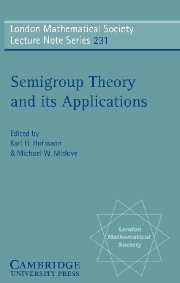 Semigroup Theory and its Applications
Semigroup Theory and its Applications Published online by Cambridge University Press: 05 April 2013
Introduction
It is a great pleasure and privilege to be speaking at a conference in memory of A H Clifford, who has unquestionably been one of the main influences on my mathematical work. I met him first nearly thirty years ago, in September 1964, when I began my very enjoyable and mathematically very fruitful year at Tulane.
Perhaps strangely, the theorem I want to talk about was not proved either by me or by Clifford. I proved the theorem for commutative semigroups, but the much deeper and more difficult result for semigroups in general was proved by John Isbell [17], who also spent Session 1964–65 at Tulane. In this brief survey I shall give only sample proofs.
Epimorphism and Dominions
Let me set the scene. In many branches of algebra the term epimorphism is used to denote an onto homomorphism. However, in category theory an epimorphism α : A → B is defined by a cancellation property: for all objects C in the category and all morphisms β, γ : B → C,
It is clear that in semigroup theory every onto morphism is an epimorphism: if α is onto, then aαβ = aα7gamma; for all a in A implies that bβ = bγ for all b in B; for every b is expressible as aα. However, while the converse result is true in groups, it is not true in rings or in semigroups. Many examples will emerge as we proceed.
Isbell's first major contribution was to introduce a related idea. Let U be a subsemigroup of a semigroup S. Let d ∈ S.
To save this book to your Kindle, first ensure [email protected] is added to your Approved Personal Document E-mail List under your Personal Document Settings on the Manage Your Content and Devices page of your Amazon account. Then enter the ‘name’ part of your Kindle email address below. Find out more about saving to your Kindle.
Note you can select to save to either the @free.kindle.com or @kindle.com variations. ‘@free.kindle.com’ emails are free but can only be saved to your device when it is connected to wi-fi. ‘@kindle.com’ emails can be delivered even when you are not connected to wi-fi, but note that service fees apply.
Find out more about the Kindle Personal Document Service.
To save content items to your account, please confirm that you agree to abide by our usage policies. If this is the first time you use this feature, you will be asked to authorise Cambridge Core to connect with your account. Find out more about saving content to Dropbox.
To save content items to your account, please confirm that you agree to abide by our usage policies. If this is the first time you use this feature, you will be asked to authorise Cambridge Core to connect with your account. Find out more about saving content to Google Drive.